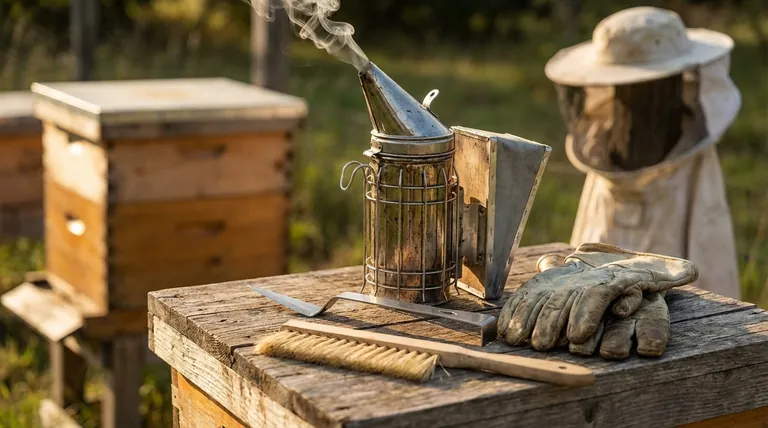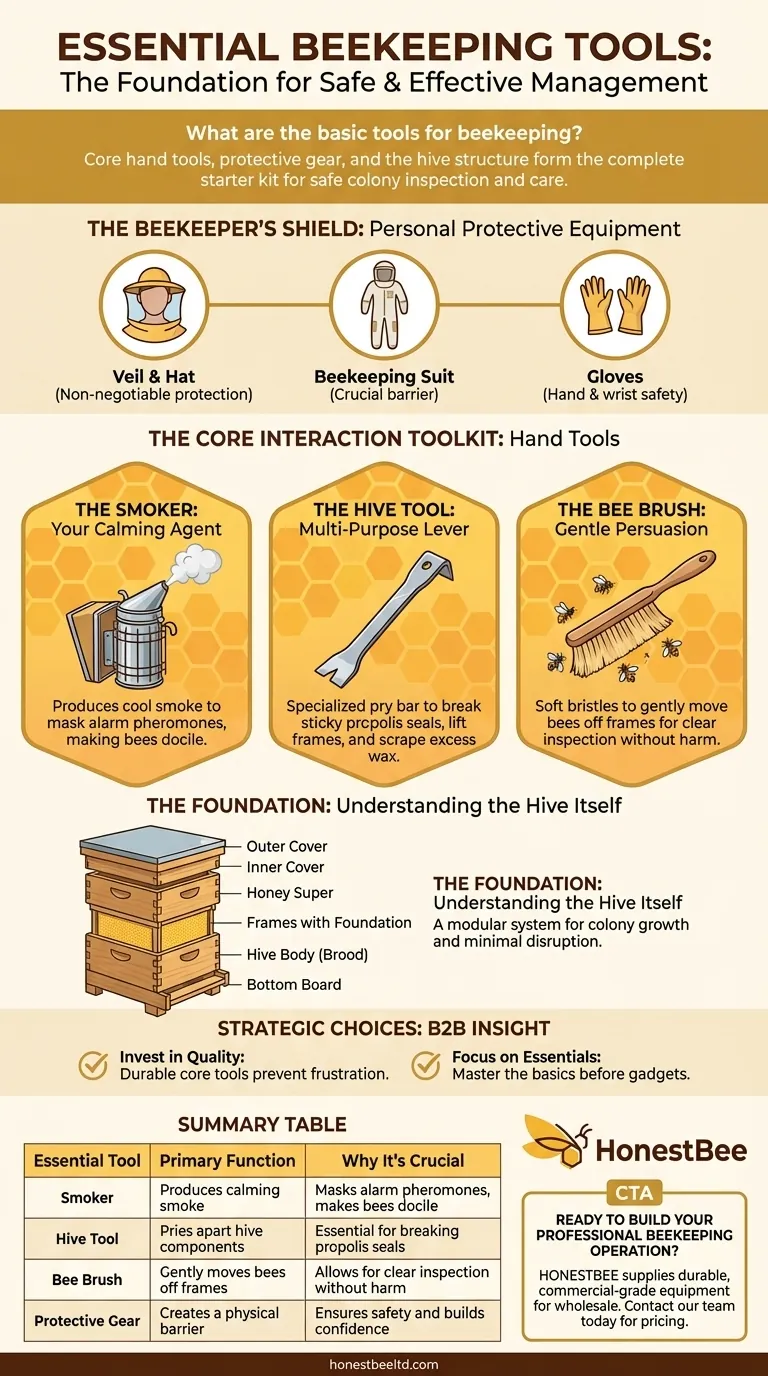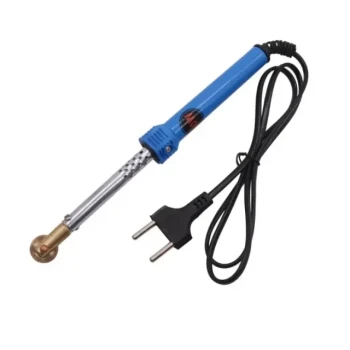To begin beekeeping, you need three core hand tools: a hive tool, a smoker, and a bee brush. These instruments, combined with essential protective gear and the hive structure itself, form the complete starter kit for safely inspecting, managing, and caring for a honey bee colony.
The fundamental beekeeping toolkit is not about harvesting honey, but about safe and effective hive management. Your first purchases should focus entirely on tools for colony inspection and personal protection, as these form the foundation of responsible beekeeping.

The Beekeeper's Shield: Personal Protective Equipment
Your first priority is safety. Bees defend their colony by stinging, and proper gear makes inspections calm and safe for both you and the bees.
The Veil and Hat
This is non-negotiable. A veil protects your face and neck from stings. It ensures you can remain calm and move deliberately even if bees become agitated, preventing accidents caused by sudden reactions.
Beekeeping Suits and Jackets
A full suit or jacket provides a crucial barrier for the rest of your body. While some experienced keepers work without one, beginners should always use one to build confidence and prevent a negative early experience.
Gloves
Beekeeping gloves, typically made of leather with long cuffs, protect your hands and wrists. They allow you to handle frames and equipment without fear, though they slightly reduce dexterity.
The Core Interaction Toolkit
These are the hand tools you will use during every single hive inspection. They are the primary instruments for interacting with the colony.
The Smoker: Your Calming Agent
The smoker is a small metal can with a bellows that you fill with fuel (like pine needles or burlap) to produce cool, white smoke.
Puffing smoke into the hive masks the bees' natural alarm pheromone, which they release to signal danger. It also encourages them to consume honey, making them more docile and less inclined to fly or sting.
The Hive Tool: Your Multi-Purpose Lever
The hive tool is the most essential beekeeping instrument. It is a specialized pry bar designed for working with the hive.
Bees seal every crack in their hive with a sticky resin called propolis. A hive tool is necessary to pry apart hive bodies, lift frames, and scrape away excess propolis or wax.
The Bee Brush: For Gentle Persuasion
A bee brush has very soft bristles and is used to gently move bees off a frame. This is crucial when you need a clear view for inspection or when you are harvesting honey and need to clear the frames of bees without harming them.
The Foundation: Understanding the Hive Itself
While not a hand tool, the hive is the single most important piece of equipment. It is the structure where your bees will live, raise their young, and store food.
More Than a Box
A modern beehive, typically a Langstroth hive, is a system of modular, precisely-sized components. This design allows the beekeeper to expand the hive as the colony grows and to inspect it with minimal disruption.
Key Hive Components
The basic hive consists of a bottom board (the floor), one or more hive bodies (deep boxes for the brood), frames with foundation (where bees build comb), honey supers (shallow boxes for honey storage), and an inner and outer cover.
Understanding the Trade-offs
Making smart initial choices can save you significant frustration and money.
Starter Kits vs. A La Carte
Pre-assembled starter kits are convenient but often contain low-quality tools or unnecessary gadgets. Buying your essential tools individually often results in better quality where it matters most: your veil, smoker, and hive tool.
Essentials vs. Gadgets
You do not need a "queen catcher," frame grips, or electric uncapping knives to start. Focus on mastering the three essential hand tools. Your needs will evolve, and you can acquire specialized equipment later.
The Importance of Quality
A cheap smoker with a faulty bellows or a flimsy hive tool that bends under pressure will cause immense frustration. Investing in durable, well-made core tools is one of the wisest decisions a new beekeeper can make.
Making the Right Choice for Your Goal
Your initial equipment purchase should align with your level of commitment.
- If your primary focus is starting on a minimal budget: Prioritize a high-quality veil, gloves, a sturdy hive tool, and a reliable smoker. These four items are the absolute foundation for safe inspections.
- If your primary focus is committing to a full, successful season: Invest in a full bee suit, a quality smoker, a hive tool, a bee brush, and at least one complete new hive with all its components.
Equipping yourself with these basic, essential tools is the first step toward becoming a confident and responsible steward of your honey bees.
Summary Table:
| Essential Tool | Primary Function | Why It's Crucial |
|---|---|---|
| Smoker | Produces calming smoke | Masks alarm pheromones, makes bees docile |
| Hive Tool | Pries apart hive components | Essential for breaking propolis seals |
| Bee Brush | Gently moves bees off frames | Allows for clear inspection without harm |
| Protective Gear (Veil/Suit) | Creates a physical barrier | Ensures safety and builds confidence for beginners |
Ready to build your professional beekeeping operation with reliable, high-quality equipment?
HONESTBEE supplies durable, commercial-grade beekeeping supplies and equipment to commercial apiaries and beekeeping equipment distributors through our wholesale-focused operations. We understand that your success depends on tools that won't fail you in the field.
Contact our wholesale team today to discuss your specific needs and get pricing for your operation.
Visual Guide

Related Products
- HONESTBEE Professional Long Handled Hive Tool with Precision Cutting Blade
- HONESTBEE Advanced Ergonomic Stainless Steel Hive Tool for Beekeeping
- HONESTBEE Premium Italian Style Hive Tool with Hardwood Handle
- Professional Dual-End Stainless Steel Hive Tool for Beekeeping
- HONESTBEE Professional Multi-Functional Hive Tool with Ergonomic Wood Handle
People Also Ask
- How can a hive tool be used to remove propolis and burr comb? Master Hive Maintenance for a Healthy Colony
- What are the features of a regular hive tool? The Essential Multi-Tool for Every Beekeeper
- How should beekeepers handle bees when using a hive tool? Master Calm, Deliberate Techniques
- What is a hive tool and what are its uses? Master Your Hive Inspections with the Essential Beekeeper's Tool
- What are some common uses of a hive tool? Essential Multi-Purpose Tool for Every Beekeeper



















